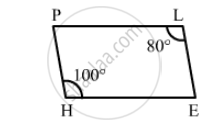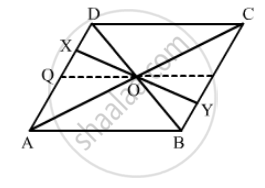Advertisements
Advertisements
प्रश्न
ABCD is a parallelogram in which ∠A = 70°. Compute ∠B, ∠C and ∠D.
उत्तर
\[\text{ Opposite angles of a parallelogram are equal } . \]
\[ \therefore \angle C = 70° = \angle A . \]
\[ \angle B = \angle D\]
\[\text{ Also, the sum of the adjacent angles of a parallelogram is } 180°. \]
\[ \therefore \angle A + \angle B = 180°\]
\[70° + \angle B = 180°\]
\[\angle B = 110°\]
\[ \therefore \angle B = 110°, \angle C = 70°\text{ and } \angle D = 110°\]
APPEARS IN
संबंधित प्रश्न
All rhombuses are parallelograms.
Can the following figure be parallelogram. Justify your answer.

If an angle of a parallelogram is two-third of its adjacent angle, find the angles of the parallelogram.
Diagonals of parallelogram ABCD intersect at O as shown in the following fegure. XY contains O, and X, Y are points on opposite sides of the parallelogram. Give reasons for each of the following:
(i) OB = OD
(ii) ∠OBY = ∠ODX
(iii) ∠BOY = ∠DOX
(iv) ∆BOY ≅ ∆DOX
Now, state if XY is bisected at O.

Fill in the blank, in each of the following, so as to make the statement true:
If the diagonals of a parallelogram bisect each other at right angles, then it is a ......
The diagonals of a parallelogram are not perpendicular. Is it a rhombus? Why or why not?
ABCD is a rhombus. If ∠ACB = 40°, find ∠ADB.
Draw a rhombus ABCD, if AB = 6 cm and AC = 5 cm.
If all sides of a quadrilateral are equal, it is a ______.
All rhombuses are squares.
